| Srl | Item |
| 1 |
ID:
127771
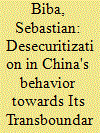

|
|
|
|
|
| Publication |
2014.
|
| Summary/Abstract |
Fresh water has no substitute, and its availability has been declining sharply around the globe. In Asia, China's role as a multidirectional and transborder water provider is unmatched. Analysis of China's behavior towards its transboundary rivers is therefore pivotal. By examining three different case studies-the Mekong River in Southeast Asia, the Brahmaputra River in South Asia and the Irtysh and Ili Rivers in Central Asia-this article seeks to lay the theoretical groundwork for understanding China's behavior. It pits previously applied realist rationales against the more recent notion of desecuritization strategies and makes a case for the latter. While desecuritization implies non- or de-escalation, it does not necessarily mean genuine long-term cooperation. The future of Asia's shared waters may thus be a contentious one.
|
|
|
|
|
|
|
|
|
|
|
|
|
|
|
|
| 2 |
ID:
125365
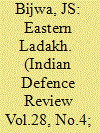

|
|
|
|
|
| Publication |
2013.
|
| Summary/Abstract |
The Armed Forces are India's "hard-power" assets and not a tool for diplomacy on the borders. Deployment of an armed force to support a diplomatic effort is axiomatic as it lends strength to diplomacy. Should "soft power" of diplomacy fail, then the will to suitably demonstrate use of "hard power" must not be found wanting. India is a Nation tugging at its leash to surge forward in all arenas of development. Without throwing caution to winds, there is a requirement to be less tentative and more assertive. India's national interests must be paramount. At stake here are the aspirations of a young generation for a bright progressive future.
"Perform necessary action; it is more powerful than inaction; without action, you even fail to sustain your own body." -Mahabharata
|
|
|
|
|
|
|
|
|
|
|
|
|
|
|
|
| 3 |
ID:
126666
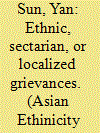

|
|
|
|
|
| Publication |
2013.
|
| Summary/Abstract |
Since its ?rst occurrence in 2009. the total number of Tibetan self-immolations had reached 97 by the end of 20l2. with an additional 10 or so in the fu'st three months of 20l3. However. our understanding of this shocking act remains limited. Why did those Tibetans resort to such an extreme form of protest? What were their motives? What were their grievances'? What objectives did they intend to achieve? Wang Lixiong. a dissident Chinese scholar-writer and respected authority on Tibetan affairs, attempts to answer these questions by analyzing the last words of more than two dozen self-immolators who had left final notes.' His data are derived from infomiation collected by his Tibetan wife. Woeser. who is also a dissident writer. Below I will introduce Wang's major ?ndings and evaluate them in the light of two competing perspectives
|
|
|
|
|
|
|
|
|
|
|
|
|
|
|
|
| 4 |
ID:
146965
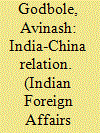

|
|
|
|
|
| Summary/Abstract |
Prioritisation of economic development and the immense scope of engagement-led development in the last decade have led to somewhat more mature India-China relations. Pragmatic leadership and an increase in people to people contact in areas of education, trade, and tourism will only create a momentum leading to deeper understanding. India and China have aimed to expand predictability in their bilateral relationship by enhancing the scope of engagement that promises a better future for both the countries.
|
|
|
|
|
|
|
|
|
|
|
|
|
|
|
|
| 5 |
ID:
125496
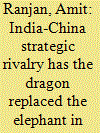

|
|
|
|
|
| Publication |
2013.
|
| Summary/Abstract |
Has China replaced or is an the process of "replacing" strategic presence of India in South Asia, is the most pertinent question, which keeps the Indian strategic community busy. It is known fact that since ancient time South Asia, as a region, had been under the influence of India; but things change since beginning of the Cold War.
|
|
|
|
|
|
|
|
|
|
|
|
|
|
|
|
| 6 |
ID:
135523
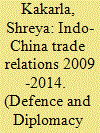

|
|
|
|
|
| Summary/Abstract |
China and India represent two of Asia’s most prominent and powerful societies today. Both these countries have enjoyed relatively high economic growth rates- India with 5.4 percent and Chins with 7.5 percent in 2014. With the rest of the China appear to be emerging as prominent powers in the global market and international affairs.
|
|
|
|
|
|
|
|
|
|
|
|
|
|
|
|
| 7 |
ID:
132803
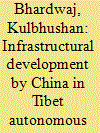

|
|
|
|
|
| Publication |
2014.
|
| Summary/Abstract |
In the 215' Century, wars will be won not merely on the fighting prowess of the armies on the battlefield but also on the infrastructural capability of the two antagonists in the area of operations. Thus, having a strong force capability coupled with infrastructural capability is an essential element in winning wars. The development of infrastructure along the lndo-Chinese Border leaves much to be desired. The lack of infrastructure including roads, railways, ammunition and housing shelters, communications, telephone/mobile connectivity, etc. is likely to hamper the logistics sustenance of own military operations against the Peoples' Liberation Army (PLA), thereby impacting successful culmination of own operations.
|
|
|
|
|
|
|
|
|
|
|
|
|
|
|
|
| 8 |
ID:
130075
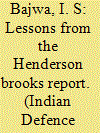

|
|
|
|
|
| Publication |
2014.
|
| Summary/Abstract |
The Government's 'White Paper' relating to India-China Boundary issue, published between T951 and i960, clearly indicated the adversarial bilateral relations between India and China. The increasingly acrimonious exchanges on the boundary question indicated that it could precipitate matters and result in armed clashes. The incident in Longju on August 25, T959 and Kongka Pass on October 21, T959 were pointers to the determination and political will at China to stake her claims even at the cost at a war. This should have been the turning point for India; she should have begun preparing for an armed showdown to secure her territorial
integrity. Raising ot additional infantry and Artillery units and tormation Head Quarters, raising of Headquarters lV Corps, augmenting the transport tleet, inducting additional helicopters and transport aircratt, constructing roads, and redeploying torces to meet possible contingencies should have been commenced in right earnest then. Such preparation was mandatory to support a strategic decision at the magnitude as was emerging.
"Nobody is driven into war by ignorance, and no one who thinks he will gain anything trom it is deterred by fear ..... ..when there is mutual tear men think twice before they make aggressions upon another" -Hermocrates as attributed by Thucydides
|
|
|
|
|
|
|
|
|
|
|
|
|
|
|
|
| 9 |
ID:
127770
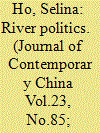

|
|
|
|
|
| Publication |
2014.
|
| Summary/Abstract |
China manages its transboundary rivers as a subset of its broader relations with other riparian states. This results in discernible differences in the way China approaches its international river systems. Although there is a limit to the extent of Chinese cooperation, in relative terms China is more cooperative in the Mekong than in the Brahmaputra. To China, Southeast Asian states are part of a hierarchical system where it stands at the apex. While problems exist, there are deep linkages between them, which help foster collaboration in the Mekong. India, which has greater power parity with China, is not part of China's hierarchical worldview. The territorial disputes and security dilemmas that characterize South Asian geopolitics further impede cooperation. Domestic considerations also impact on China's river policies. There is greater consensus among Chinese policymakers in managing the Mekong than the Brahmaputra, which explains the higher degree of clarity in Chinese policies towards the former compared to the latter.
|
|
|
|
|
|
|
|
|
|
|
|
|
|
|
|